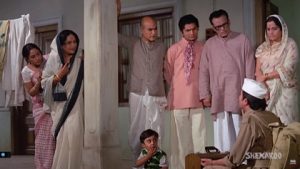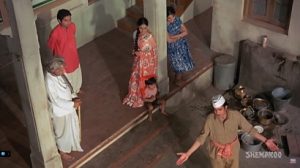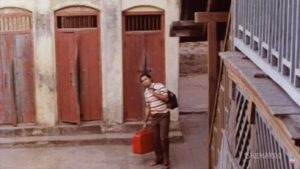Bawarchi and Katha: The Production of the Urban Home
Ketan Krishna
ABSTRACT
This paper analyses the representation of domestic spaces in two films – Bawarchi (Hrishikesh Mukherjee [1972]) and Katha (Sai Paranjpye [1983]). The “homes” in these films are taken as “social spaces”, as theorised by Henri Lefebvre, and have very specific spatial codes owing to their socio-historical contexts and to the fact that they are carefully constructed representations. Rising industrial capitalism and its allied consumer culture of the 1970s in India led to a new mode of citizenry in the urban city, as well as new forms of familial, conjugal and domestic spaces. This article textually analyses these films as works of art with embedded ideological statements and studies the way in which conflicts are set up and resolutions are put forward. The contrived nature of these conflicts and resolutions shall highlight the nature of these domestic spaces as produced social spaces, which implies labour. This labour is the work done in the transformation of the “house” to the “home” (within the film), and is analogous to the labour of the filmmaker in the contrivance required for the resolution of the plotline in the film. The effort, therefore, is to unearth the hidden labour that goes into these transformations and, thus, highlight the ideological bedrock that sustains and perpetuates the produced “home”.
KEYWORDS
domestic space, Bollywood, 1970s, urban space, labour, social space, home
INTRODUCTION
Throughout the history of Hindi cinema, the domestic space has often been an important location—both as a setting where the plot plays out as well as the very source of the conflict. The home is also the primary interface between public and personal lives. One’s initiation into society begins with one’s initiation into the family. Moreover, the outside world permeates into the domestic one and creates cultural, social and economic codes which impose themselves on the physical space. Issues such as gender roles; sexual, parent–child, or master–servant relationships; aspirations and social mobility; conjugal privacy, etc., can be studied to examine larger issues.
Keeping this in mind, this paper looks at the two specific representations of domestic space in Hindi-language cinema—Bawarchi (Hrishikesh Mukherjee [1972]) and Katha (Sai Paranjpye [1983]). The 1970s were a time of turmoil for the nation in many different fields. The Nehruvian era of all-encompassing, socialist, macro reforms had mostly faded, and a new sense of nation building under Indira Gandhi was underway. The idea of the government as “mai-baap” (parent-protector) seemed to have given way to a new class consciousness where the citizen-as-individual was called upon to fulfil his or her role as a member of the nation (Rajagopal 2011). The personal spheres, although never free from the outside world, became markedly more enmeshed within political discourse. In this condition of urbanism, the middle-class home became a significant site.
Through tracing and studying the contrivances that play out in these films of the 1970s, the effort shall be to understand how the domestic space is produced as such in the cinematic domain. The “how” indicates both the labour and the imagination that contribute to the production of the middle-class domestic space. These processes are constructed through social relations of gender, class, or even other hierarchical social systems, but are articulated and reflected in the form of these cinematic representations grounded in the context of urban capitalism and a nascent consumer culture.
In his chapter “Social Space”, Lefebvre (1974) envisions a three-pronged understanding of space: the perceived, the conceived, and then the “lived space”. Lefebvre, thus, calls for “social space”, which is at once produced by systems of meaning, symbols, and representation, and at the same time also a factor of production. He insists on looking at modern capitalism spatially through the experience as well as production of (social) space.
In his books Rhythmanalysis (Lefebvre 2004) and Critique of Everyday Life (Lefebvre 1991), he focuses on the temporal experience of space, and the spatial experience of time, driving towards spatio-temporality of human experience. He points to the “rhythms” of daily life—activities that do not really have a beginning or an end, but operate in a recurring cyclical patterns with particular intervals.
If the homes in these films are produced, then the process of production involves relations of production. Some labour is involved in the production of the domestic space as such. If one looks at the domestic space as social space, then through the practice of it, it has its own spatial codes. This social space is thus produced, while also acting as means of production. The effort of this analysis shall be to look at how the cinema of this period produces the social space of the home and what it produces in turn.
An essential plot device in these films is the transformation of the “house to “home”—an implied labour that makes the physical space the site of the family or the community. Following from Elisabeth Bronfen (2004), the home is also associated with the danger of its loss—the feeling of not being at home or being estranged from it. This essential duality is mediated by the social themes of gender and class. Issues such as privacy, exclusion, formation of a community, formation of family, modes of masculinity and civility, and aspirations of wealth and mobility become plot devices in narratives set in an era where commodity culture and urban lifestyle is making inroads.
Through the 1970s and 1980s in India, as the Nehruvian era of the protective, parental government faded away, a new social culture based on the citizen as an urban consumer-member developed. The films, Bawarchi and Katha, are set in this socio-historical context. Rachel Dwyer (2006) distinguishes between representations of an “old middle class” and a “new middle class”. She writes that while the cinema of the 1970s was about an older middle class, the cinema from there on captured the spirit and the imagination of the “new middle class”—a class that is still located within the middle class but “its consumerist lifestyle opportunities are those of the rich” (Dwyer 2006: 227). M. Madhava Prasad (1998) uses the term “middle cinema” to refer to “middle-class” cinema, and says that this “middle cinema” was part of a larger “realist programme”, which also included the films of Mrinal Sen and Shyam Benegal. About middle-cinema, he writes,
As spectators the audience of citizen-subjects were called upon to occupy two different positions. One corresponded to the citizen side of the entity and involved a frame of reading that included the perspective of the nation-state while the other was addressed to the subject, the individual in society, faced with the struggle for existence, the locus of desires, fears and hopes. (Prasad 1998: 162)
While the theme of class consciousness and the spectator as citizen-subject are relevant, this analysis shall not attempt to follow Prasad and Dwyer in viewing these films as realistic portrayals. In fact, the films are often self-reflexive about being works of art—while Bawarchi is introduced by Amitabh Bachchan’s voice as a play, with its setting and characters, Katha is set up as an adaptation of the fable of the hare and the tortoise.
Instead, this analysis shall employ a “symptomatic reading” of these films. Althusser (1970: 27–9) writes that such a reading highlights the assumptions and presuppositions that the text is based on, which allow for some things to be invisible within the text—things that cannot be thought or said in the text. These films are deliberately plotted movements from conflict to resolution, set in and affected by the domestic social space. As such, this movement from conflict to resolution is made possible by this invisiblisation of certain social themes. These social themes, which operate in the domestic space, are the subject of enquiry of this analysis.
I
Bawarchi (1972) was directed by Hrishikesh Mukherjee, and stars Rajesh Khanna as the titular bawarchi (cook), supported by Asrani, Jaya Bahaduri, and others. Like several of Mukherjee’s films, Bawarchi is genially light-hearted in tone and set in a familial space. Like other Mukherjee films, it does not shy away from its own theatricality and performativity, and, in fact, declares itself as an enactment.

Figure 1.1: The familial house that the film is set in
THE SETUP
The film begins with a narrated introduction like one would see in a staged play. Amitabh Bachchan’s voice announces the production house, the name of the film, its writers, cinematographers, writers, sound recorders, artists, singers, and so on. Using Amitabh Bachchan as a narrator and opening the film with a parting of the curtain declares a rejection of verisimilitude and highlights that the people that we are going to see are “actors” who are there to play certain roles. Citing the location as “any house in India” further inverts the relationship between the house and its representation, pointing to the idea that every real house, in fact, has actors who need to perform their roles to maintain the house as “home”. These roles are the everyday practices of the domestic space which constitute the “social space”.
This is essentially a large joint family house (Figure 1.1). In the opening shots, we see all of these characters in their own rooms engaged in regular activities. Although it is called “Shanti Niwas” (shanti meaning tranquillity, and niwas meaning residence), we are told that the house is constantly noisy and chaotic. The constant tedium of the house has made the cook run away. Fed up with his masters, he decides to leave, willing to work even for slightly lesser pay. This leads to the event that signals the crisis in the house—the morning tea is not served. All the family members blame each other for this situation. Ultimately, the responsibility falls on Krishna, the orphaned granddaughter, to make tea for everyone and restore some sense of normalcy in the house (Figure 1.6). It is also revealed that not all members of this joint family stay in this house out of choice. Kashinath and his wife want to leave but stay on so that they are not excluded from the inheritance when the patriarch dies.
Shivnath hesitates in asking his family members to do chores because the wives of his sons are “daughters-in-law”. The “in-law” part of the relationship denies him the authority through kinship to command them to serve the house. Krishna, however, genuinely wants to live in the house—she is willing to perform household work which everyone else shirks away from. As she prepares tea for everyone and carries it around chanting “chai garam” (hot tea), we see a glimpse of the family falling back into order.
THE ARRIVAL
All of this is changed by the arrival of Rajesh Khanna’s character, a bawarchi named Raghu (Figure 1.2). Shivnath comments that his arrival is like the coming of a god. Krishna rouses the whole family to meet Raghu, and they all gather around him in the patriarch’s bedroom. Raghu immediately begins to seduce the family by using his gift of the garb. Raghu is viewed with admiration by some and suspicion by other members of the family. He spins yarns and creates a religious/mythical aura around his set of kitchen implements. His demeanour reeks of overfamiliarity and flattery and sets him up as a possible conman. It is hinted through suspicion of the youngest son that Raghu might be there to swindle the family and steal the patriarch’s trunk. He has the character traits of the storyteller of a bygone era, as well as the almost feudal values of what “service” means in a domestic sense. However, these values do not coincide with the general socio-economic atmosphere that the family members know is prevalent in the urban world, resulting in a suspicion that stems from the sense of him being too good to be true. Raghu begins to unify the family around him. While Krishna would take the tea to everyone individually, Raghu insists that everyone should sit together and drink tea. He thus transforms the central courtyard into a site of action (Figure 1.3). The family gathers there for meal times, etc. Gradually, the familial relations between them also start to improve. Raghu fosters love between the sons and their wives, helps them do what they want in the house without affecting other, and performs their domestic chores in their place.

Figure 1.2: The bawarchi arrives

Figure 1.3: The bawarchi unites the family
He even sleeps in the central courtyard and has become a sort of a domestic deity. The song “Bhor Aai Gaya Andhiyaara” shows the whole family coming together and celebrating in the centre of the house (Figure 1.4). Even the patriarch, who rarely leaves the room, is out singing. At the centre of it all is Raghu, the bawarchi. As soon as this crescendo of familial harmony ends, the event that has been foreshadowed throughout the film happens— he steals the contents of the patriarch’s trunk and disappears. The suspicion of the family members and the audience alike seem to have come true.
THE TWIST
However, in the plot twist, it is revealed that Raghu manufactured the elaborate ploy of stealing the trunk and absconding, so that Krishna’s love interest, Arun, could claim to have caught and stopped him and return the stolen items, thereby winning the favour of the whole family. At the end of the film, it is revealed that Raghu’s true identity is that of a professor in disguise. Discontent with the knowledge, wisdom, and skill that he had amassed, he finally arrives at the realisation that true happiness can only be found through love, and he makes it his mission to share and spread love in the world. To do this, he seeks out dysfunctional homes where people have material wealth but have lost love for each other. He enters these houses as a servant, a cook, etc., and he does not teach them anything new—only about the love that they have forgotten. When Krishna requests him to stay on at their house, he replies by saying that there is a moral imperative that he must now follow, and go to another house and fix it. The narrator’s voice closes the film by hoping that the house that Raghu visit’s next is not the viewers’.

Figure 1.4: Still from the song “Bhor Aai Gaya Andhiyaara”
This exposition is essentially a critique of the lost “love” in urban life. Material concerns have denigrated the ideal of the joint family, and Raghu sets out to correct this. However, it is crucial to note the method that the narrative employs for this correction. Raghu—a man of privilege, equipped with modern knowledge and culture, chooses the role of the servant. He offers a version of labour that is alien to the family—not only does he ask for less pay than offered, he also does many more tasks than that are asked of him. This is in complete opposition to the previous cook, who leaves the house at the beginning of the film due to adverse working conditions. He is willing to sacrifice his pay to get away from the constant dysfunction of the domestic space, even if it means going to work in a restaurant. This is a form of labour the urban audience would be more familiar with—the worker who works for remuneration or compensation. The purely transactional nature of the relationship between the master and the servant is the norm in the socio-economic structures on which urbanism is built. The “masterless men”, uprooted from the rural economy and migrated to the city, have broken away from the traditional moral imperatives and compulsions and have the agency (at least in theory) to choose the best mode of employment available to them. When the cook leaves, no one in the family is actually surprised.
The task that Raghu has cut out for himself, however, is not based on providing labour in an economic transaction. He is instead harking back to an older tradition of “duty” that the servant performs for the master. The “Ramu kaka” figure that is often seen in Indian cinema has parallels with Raghu’s character. Both are entities from a tradition where the servant was an organic part of the master’s household. The servant thus has to perform emotional labour in addition to the physical labour that he is paid for. Raghu has identified the daily rhythms like making tea and snacks, mixing drinks for the eldest son, and so on. However, his constant flattery, compliments, unsolicited advice, and moral lessons of familial goodness are also part of a rhythm of emotional labour that has to be performed by someone. If, in the modern capitalist, the concept of “care” has become reified and commodified into a “service”, then Raghu’s efforts are to take this economic value away from this labour and give it an almost divine value. In the film, the family members compare his arrival to the coming of a god. To add to this, he carries a box of ladles (Figure 1.5) with him which he claims to have been a gift of the goddess Annapurna. At one point, he also mentions that doing housework should not be considered “work” at all, but a fundamental spiritual duty that fosters love and care.

Figure 1.5: Raghu’s divine ladles
The domestic space of the joint family in Bawarchi is produced as social space, which implies that someone has to put resources and labour into it. While it is clear that the labour is provided by Raghu, it must be noted that it is not recognised as such. The exploitative nature of the work that the servant is expected to provide is normalised through codes of religion and morality. While it might grant the servant divine status, it also imposes a religious imperative, leaving him susceptible to exploitation. Embedded in the practice of domestic space are codes of oppression and exploitation, which, in turn, are perpetuated. The work that the servant has to provide is hidden behind problematic ideas of family and community. It is not, in fact, the organic lived experience of the joint urban family itself that produces the social space, but the physical and emotional labour provided by the servant.

Figure 1.6: Krishna has to take up Raghu’s role
II
Sai Paranjpye’s Katha was released in 1983. The film stars Naseeruddin Shah, Farooq Shaikh, and Deepti Naval, and is based in a chawl in urban Mumbai. The chawl originally came up as a communal housing structure for textile mill workers in Mumbai. However, by the 1970s and 1980s, the chawl had become the domain of the lower-middle class. It had a sort of liminal position between community housing and private housing. It had the character of collective housing, while also allowing for private quarters for individuals and nuclear families. Katha is based on a Marathi play by G. Sathye titled Sasa aani Kasav, meaning “the hare and the tortoise”. This reference to the old fable is a major part of the film too, which begins with an animated sequence based on it.

Figure 2.1: The animated opening sequence
THE FABLE
Katha begins with an animation of the story of the hare and the tortoise (Figure 2.1). The title “Katha” implies a fable—a parable of good and bad. In the original tale, the tortoise wins on the basis of his “steadiness”. However, in the film’s version, the hare flits through the race, stopping in places to eat carrots, flirt with other animals, and ultimately piggybacks on the tortoise itself and jumps in front of him at the finish line.
This initial comment on the “change of times” sets the tone for the film, which itself is a play on the old fable. The change that is the subject of this film is in the system of morality, ethics, and basic human relationships, which have been brought about by a movement from the old times to the “present times”. The tradition of storytelling itself belongs to a certain time, period, and place. With the onset of city life and urban experience, these values cannot be used as are for the perpetuation of the urban experience and, hence, need to be reconstituted with a different functionality so that they can be used as a means towards an end. When the grandmother stresses the importance of “image” one puts forth of oneself, it is because of the importance of representations in the urban world. One does not need to be a hard worker as long as one is “seen to be” a hard worker. But also inherent in this comment on the “new way of life” is a condemnation of it and, hence, it is a moral tale.
The reference to the fable serves as a sort of epigraph to the film, and after that, the physical setting of the film—the Mumbai chawl—is introduced. As Rajaram (Naseeruddin Shah) enters the chawl, there is a group of children playing cricket in the central courtyard. He climbs the staircase to the upper floors while announcing to everyone that he has become “permanent” (at his job). As he enters the door, he hails his mother and father. At this point, we find that he lives alone in the room, and the parents he refers to are photographs on the wall. Next, his neighbour Sandhya enters the scene. Rajaram is visibly smitten by her. She goes on to help him put up a new name plate, which he has been saving for the day he becomes permanent. This name plate has a sliding panel of wood which indicates if he is “in” or “out”. Everyone suddenly sees it and they all gather around to appreciate his promotion as well as the name plate (Figure 2.2).

Figure 2.2: Rajaram celebrates his promotion and new name-plate
The nature of the chawl is like that of a very large joint family. It is not clear what the blood relations between the people are. The grandmother, the mother, the “bapu”, the sister-in-law, all seem to belong to the same family in their interactions with each other. Even the bickering seems to be a part of the organic continuum of the chawl. Rajaram’s parents are in the village, but he has even found proxy parents in the form of “bapu” and “maaji” in the chawl. He seems to serve them with the same devotion that a son would. There is also a generally accepted lack of privacy in the chawl. The couple, complaining mutedly about privacy, are only heard through a closed window and are never in the frame themselves. Moreover, the residents of the chawl drift in and out of each other’s quarters without much thought. The spatial code of the chawl does not have any strict protocol of entry and exit or of personal territory. Sandhya happens to be in Rajaram’s house without him inviting her, or she herself worrying about it too much. It is understood that she would bring him tea in the evening.
As Rajaram enters, he is eager to let everyone know that he is now “permanent”. The fact that he is celebrating permanence or stability is an indication of his character, as well of the social universe he inhabits. The recognition that he desires is within the space of the chawl. He already has a name plate made for the day where his private and public lives can come together in a state of stability. The first step to this was to get a permanent job and the second step is to propose marriage to Sandhya. Even his name plate is a marker of the bureaucratic office—the sliding panel shows if he’s in or out. He has the naivety of a character like Don Quixote—a man out of time, who is on a civilising mission. He even has an old grandfather’s clock that does not work anymore—a sign of Rajaram’s temporal stasis.

Figure 2.3: Bashudev arrives
THE OUTSIDER
It is at this point, just as people gather around Rajaram to admire his success, that there is the entry of an outsider into the chawl (Figure 2.3). The “baahar ka aadmi” is Bashudev, Rajaram’s old friend.

Figure 2.4: The chawl breaks out into song and dance, united by the arrival of Bashudev
The arrival of Bashudev acts as a major interruption in the daily machinations of the chawl. He is an outsider and instantly becomes the object of fascination and curiosity. Bashudev treats the chawl very differently from how Rajaram treats it. When he enters this space, he surveys it. His gaze is totalising—he tries to see the chawl as a single unit, a sum of its parts. As he ascends to Rajaram’s quarters, he completely ignores the fascination of other people. At this point, he makes no effort to interact with the residents around him. When inside the quarters, we see that his mannerism and behaviour are also very different from Rajaram. He uses words like “enchanted”, he smokes cigarettes, wears T-shirts, and says that he has been in England for a while. He has now returned to “conquer Mumbai”. If Rajaram is a man displaced in time, trying to be part of a community, then Bashudev is a person who has never been grounded in space and time. He is, even in the ontological sense of the word, an outsider. Bashudev’s way of life is based around the gift of the gab—he is a sweet-talker who can weave yarns and charm people by adapting his mannerisms and behaviour to their liking, as well as falsifying his own narrative.
This difference is made even starker in the different ways in which Rajaram and Bashudev manage to procure tea. When Rajaram goes around the chawl looking for milk for tea, he overhears a woman complaining about a cat, a couple getting intimate, and so on. He finally ends up in the invalid old man’s room. The man readily agrees to give him milk, but he also asks Rajaram to help him sit up, put eye drops in his eyes, switch on the radio, and write a postcard. By the time he returns to Bashudev with the milk, he finds that his friend has already arranged for tea to be brought to him by another neighbour. The plot is then interrupted by a song based around the lyric “Kaun Aaya” (Who has come). During the song, the camera pans across the various parts and residents of the chawl. This also includes the cats, monkeys, and parrots. Along with the balconies of the chawl, the song also shows glimpses of the diverse interior spaces. One woman is making lassi, another is praying, a man is watering plants, a couple is sitting on a sofa, and so on. At the end of the song, all the members of the chawl can be seen dancing in the centre courtyard and the balconies (Figure 2.4).
Rajaram goes around the chawl, negotiates its idiosyncrasies, and operates within its own economy of exchange. To get milk from the old man, he has to operate within the symbolic father–son relationship where he calls him “bapu”. As a “son” figure, he must also perform the duties of one. Rajaram hence exchanges his labour—both emotional and physical—for a cup of milk. He is dependent on the spatial code of the chawl for his existence. Not only must he abide by it, he must also perpetuate it. On the other hand, Bashudev only has to complement a neighbour and her son to get her to make tea for him. Bashudev has recognised the social economics of the chawl, and very calculatingly exploits it for his own advantages. He knows that in appearing like a cultured and westernised man-of-taste, he can force himself into the social structure of chawl in a way that he does not materially have to provide anything except the labour of imagination. He exchanges tea for the images he conjures up for both himself and others. These images take the form of compliments about others, inflated fictional representations of himself, and so on. The outsider recognises the simulacra of symbols and images that structure the space, and he alters this system to carve a space for himself. At the end of this scene, when all the residents start singing the song about the newcomer, it is with a sense of excitement and joy. Bashudev manages to agitate the class aspirations of the chawl as a whole into a state of carnivalesque giddiness, which sublimates in song and dance. The mundanity of the everyday life in the chawl is broken by the arrival of Bashudev, but simultaneously, this anomaly is being reabsorbed into the system when we see the people going about their daily tasks towards the end of the song.
Bashudev slowly befriends the residents and gets himself invited to the quarters of a couple. The couple proudly shows him their “imported TV” (placed inside a wooden cabinet with photos of Indian sculptures plastered across it); a big, modern, fully stocked fridge; their folding table and folding partitions; and so on (Figure 2.5). They inform him that all of these luxuries have been set up by their son, who is a doctor in Canada. Bashudev compliments their house and appreciates that their non-resident Indian (NRI) son has not forgotten Indian tradition. The man replies that although their son wants them to move to Canada, “Once one has lived in a chawl, one can’t live anywhere else.” He then elaborately opens the folding table, and they drink “chilled beer”. Meanwhile, Rajaram is at a bus station, struggling to get people to stand in a queue, and raging at people’s lack of “civic sense”.

Figure 2.5: The TV set placed like an idol in a temple
This sequence brings two important things to light. The first of these is the increasing signs of commodification in the domestic space. Even though Rajaram is a model of moral propriety and strongly grounded in traditional values, he has also absorbed and internalised the consumption of commodities. He has already fetishised consumption of cigarettes and beer by limiting it to special occasions and birthdays. Similarly, in the quarters of the couple, there are several different types of imported luxuries. Like Baudrillard (1968: 16) says, these commodities have become “household gods” in the domestic space. The way that the man opens the cabinet to show the TV has very obvious visual parallels with the mandir (temple) that most Indian households have. There is also a ritualistic nature of opening, closing, and using these commodities. It is also useful to note that these commodities have been made possible through the link with the West (Canada). In the limited living space available in the chawl, when the folding table is unfolded and the cans of “chilled beer” are cracked open, the theatre of the middle-class chawl is in motion. The urban chawl in Mumbai, therefore, is not a community based on old and traditional values alone. It has encountered the unfamiliar—often alienating—urbanness of the city, and assimilated it into its everyday spatial praxis.

Figure 2.6: Rajaram tries to civilise people at the bus station
In the city itself, however, is Rajaram struggling at a bus station. Outside the chawl, Rajaram is like a fish out of water. Like Don Quixote, he tries to “civilise” the unruly crowd into getting into a line and wait for the bus (Figure 2.6) and accuses them of not having “civic sense”. However, it looks more like Rajaram himself is unfamiliar with the actual spatial code of the chaotic city. When Bashudev is at the same bus stop later in the film, he manages to get on the bus with ease. The “civic sense” that Rajaram lives by is an idealistic spatial vision, based on values of law and order in a civil and modern world. It is devoid of real-world considerations of how the city actually functions. It is no wonder then, that his boss tells him that he does not understand art—the practice of images. On the other hand, Bashudev has no regard for the “civic sense” that Rajaram endorses. When a government survey official mistakes him for Rajaram, he does not correct him, and promptly gives false details for the national survey—an action that, for Rajaram, would amount to disrupting the national machinery and, hence, blasphemous. Bashudev, however, does not do this for any discernible profit or advantage, rather only to amuse himself.
Rajaram’s world is rapidly being taken over by Bashudev, but he fails to see that he is being conned. Having already taken over Rajaram’s bed and adorned the walls with his own posters, Bashudev even takes Rajaram’s savings from his always open almirah. Eventually, things begin to boil over as Rajaram’s boss finds out that Bashudev has had an affair with his wife, while simultaneously also seducing Sandhya—Rajaram’s love interest. Sandhya’s parents visit Rajaram and ask him to request Bashudev to marry their daughter. Rajaram is heartbroken but agrees. Preparations for the wedding begin at the chawl and the whole community is involved in them. On the wedding day, Bashudev absconds. Sandhya’s parents then request Rajaram to marry her instead, and Sandhya reveals that she might be pregnant with Bashudev’s child. Rajaram claims that he has always loved her and accepts the marriage. The celebrations in the chawl resume, and it is indicated that Bashudev has left the country.
This trajectory shows how the “hare” and the “tortoise” have fared in the world. After conquering the chawl, Bashudev spreads his wings further and cons his way into a different domestic space—that of Rajaram’s boss. Meanwhile, Rajaram grows gradually more alienated from his own social space in addition to the world outside. Bashudev has bent the social fabric of the chawl to an extent that cannot be maintained. Till now, Bashudev has been a cypher—he has taken on positions and signification as per whatever benefitted him or gave him pleasure. When the prospect of marriage ambushes him, along with his affair being found out by Rajaram’s boss, his situation becomes untenable. At that point, it is obvious that Bashudev is going to run away. Rajaram, however, fails to see this. His excessive goodness is little more than naivety in the urban world, and it ultimately threatens to destroy his social universe. However, the plot of the film still offers him a chance to redeem himself as well as the values he holds dear. His act of agreeing to marry Sandhya, despite the possibility of her being pregnant with another man’s child, affords him a chance to restore order to his world. By returning to a traditional code of masculinity—one that promotes gendered chivalry and gallantry as the markers of “civility”—Rajaram manages to avert the disruption and destruction of the social space of the chawl.
COMPARATIVE ANALYSIS
If one compares Hrishikesh Mukherjee’s Bawarchi with Sai Paranjpye’s Katha, there are some thematic similarities. While Katha is set in a chawl, which functions like an extended family, Bawarchi is set in the house of an actual joint family. Both of them have the arrival of the outsider—in Katha it the protagonist’s friend Bashu, while in Bawarchi, it is a cook. Both these characters are set up as possible conmen who flatter the residents and manage to become the centre of attention.
The difference is that in the case of Bawarchi, Raghu enters a domestic space that is in turmoil. He utilises the passive suspicion of the family members to set himself up as a conman, and ultimately create a crisis (the theft), which can be resolved (by someone else) and, hence, return peace, order, and love to the household. After all of this, the outside agent must leave the space that he has transformed. In Katha, Bashu enters a space that already has peace and a harmonic order in place. In this case, he exploits the passive naivety of his friend—the gullible Rajaram—to reap benefits from the chawl.
It is also necessary to look at the exact method that Raghu uses in Bawarchi for his goal of reminding the family of the love that exists between them. Like Katha’s Rajaram, he too is on a mission, but the mission is not to “civilise” in the urban sense of the word. Raghu’s aim is to return the chaotic and dysfunctional family to its idealised form that is only found in stories of bygone times. The “house” that is transformed into “home” through “love” is the essential idea he works with.
In Katha, on the other hand, the domestic space is produced as social space through the labour performed by Rajaram, acknowledged only through the concept of the familial duty transposed and adapted to the urban space of the chawl. Just like the Rajaram’s labour, the chawl also assimilates markers of consumerism and modernity into its environs. When the outsider, Bashudev, causes a crisis by upending the spatial praxis of the chawl, it is only through a gendered and uneasy resolution—that of turning to a pre-urban model of chivalric masculinity—that the crisis is resolved.
In fact, the epilogue of Katha offers a self-reflexive critique of its resolution—as the fable of the hare and the tortoise ends, the old grandmother who was narrating the tale makes another appearance. This time, the tortoise has won, but the grandmother says, “What sort of victory is this?” This comment undercuts not only the overzealous and arrogant masculinity embedded in Rajaram’s chivalry, but also the nature of resolutions that these films posit.
CONCLUSION
The objective of this analysis of Bawarchi and Katha was to highlight the ways in which domestic space is produced in these films. In both films, there is a central tension between the idea of the house—the actual physical space that constitutes the place of living—and home—the social space that is a result of a transformation of the physical space through some form of “work” done. They feature the entry of an agent from outside the domestic space who affects, or threatens to affect, a transformation with regard to the aforementioned binary. In Katha, the external agents threaten to upend the internal order and destroy the social relationships and spatial codes that make “home” what it is. In Bawarchi, on the other hand, the external agent acts as the force that brings together the segregated parts of the house into the unified entity—“home”.
The Urban Home
The fact that the domestic sphere is a crucial space for such interventions brings one back to the subject of home with the advent of urban modernity and its allied consumerism. Home as the site of private consumption is essential to the functioning of urban capitalism. This concept is articulated strikingly through the use of tea as an essential plot point in both the films. In Bawarchi, the conflict arises because the morning tea has not been served, and is resolved by the re-establishment of “tea time” as a ritual family practice. The bawarchi is instrumental in making the house becoming a home through unifying spatial codes like gathering for meals and tea. In Katha, the procurement of tea becomes a key plot device through which the social economics of the chawl is illustrated. Commodity culture has seeped into the chawl and become normalised such that the procurement of tea involves an elaborate ritual of labour exchange that has replaced familial codes. Rajaram has established the chawl as his family and himself as the son of the chawl in a way that assimilates consumption into the spatial code of the community. The arrival of Bashudev and the way in which he short-circuits this spatial code, manipulating it to his advantage by procuring tea through flattery.
Labour and Imagination
Hence, the domestic realms in these films are held together by an elaborate ritualised practice, a practice which involves two aspects—labour and imagination. These two are the work that goes into the production of domestic spaces, and both must be done simultaneously for “home” to be possible. For Rajaram to be at home in the chawl, he must perform all the ritualised labour expected from him, while also imagining himself as the “civilised” modern citizen, successful both as a private and public individual. In Bawarchi, it is the elevation of the domestic labour provided by the servant to a pseudo-spiritual duty, to the extent that he must also provide emotional labour and himself as a member of the family and not just a servant. The film promotes the concept of “working for the home” as not just work done for remuneration but as a familial duty with almost divine sanction.
In the context of the modern city, this “home” has to sustain the onslaught of urbanism, which entails the industrial economy and its markers—consumerism, working-class insecurities, limited spaces, and so on. However, as the alternate ideal of communal spaces within the city—such as the joint family or the chawl—arise, there is the tendency to romanticise these spaces, too, as successful negotiations of urbanity that manage to adapt and provide shelter—physical, emotional, and social—from the oppressive machinations of the city.
These domestic spaces are not as tidily and organically successful as they appear on the surface. It is only through specific channels of labour that are based on very particular social relations that the home is successfully produced. When this labour goes unrecognised—obfuscated or subsumed into uneasy categories such as that of the “duty-bound servant”, the “good daughter”, or the “good son”—the result is a narrative structured on problematic social realities. The mental and emotional labour that the servant is obliged to provide because of the promotion of familial work as divine duty is hidden and obfuscated by the happy resolution of Bawarchi. Moreover, after the servant leaves, the work seems to be inherited by the orphaned daughter by default. This assumption is treated naturally, but is, in fact, a gendered and hierarchical assumption. In Katha, Rajaram emerges as a sacrificing hero willing to forego the ideal life he has planned for himself, in order to act as the honourable knight who saves the maiden in distress by doubling up on chivalric masculinity. These tensions offer commentary on the gendered and hierarchical nature of the social relations, but can get buried under the neat resolutions that the film narratives offer.
These resolutions have been engineered on the basis of the popular imagination—with the assumption that the spectator shall find the resolution plausible. Inherent in this mechanism is a jump—the film intends to make the spectator bypass thinking about the crisis itself, and move directly from the crisis to the posited resolution without thinking of it is as uneasy. The spectator’s function of imagination and analysis of the crisis is, hence, bypassed by the narrative, which takes upon itself the task of imagining the resolution out of the crisis and positing it as natural and organic, even if it is not actually so. Through an Althusserian symptomatic reading of these films, these assumptions and symbols are uncovered and are understood to constitute the ideological framework of the texts. This framework allows for the “unthinkable”—the obfuscated, hidden labour—to exist beneath the domestic social space represented in these films.
Ketan Krishna is an MPhil candidate at the Centre for Media Studies, Jawaharlal Nehru University, New Delhi. His research is centred on user-generated audiovisual content, Internet cultures, and technological change. He also works as a freelancing video editor and researcher. He holds a master’s degree in media and cultural studies from TISS, Mumbai, and a bachelor’s degree in English literature from Hindu College, New Delhi.
REFERENCES
Althusser, Louis and Balibar, Etienne (1970) Reading Capital, translated by Ben Brewster. London: NLB.
Baudrillard, Jean (1968) “Structures of Interior Design”. In: James Benedict (trans.). The System of Objects. London: Verso. pg. 15–29.
Bronfen, Elisabeth (2004) Home in Hollywood: The Imaginary Geography of Cinema. New York: Columbia University Press.
Dwyer, Rachel (2006) “Bollywood Bourgeois”, India International Centre Quarterly. 33(3/4): 222–31.
Lefebvre, Henri (1974) ‘“Social Space”. In: Donald Nicholson-Smith (trans.). The Production of Space. Oxford: Blackwell. pg. 68–168.
Lefebvre, H. (1991) Critique of Everyday Life. London: Verso.
Lefebvre, H. (2004) Rhythmanalysis: Space, Time, and Everyday Life. London: Continuum.
Prasad, M. Madhava (1998) “Middle-Class Cinema”. In: Ideology of the Hindi Film: A Historical Construction. New Delhi: Oxford University Press. pg. 160–87.
Rajagopal, Arvind (2011) “The Emergency as Prehistory of the New Indian Middle Class”, Modern Asian Studies. 45(5): 1003–49.

